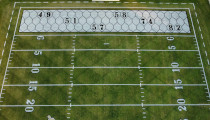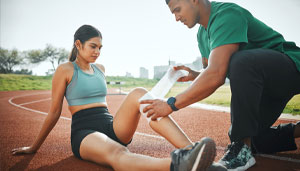Reporting Catastrophic Injuries Promotes Improved Safety
By Kristen L. Kucera, PhD, MSPH, LAT, ATC on November 09, 2023 hst PrintParticipation in organized sports is returning to pre-pandemic numbers in the United States, with more than 7.8 million high school-level participants and more than 500,000 college-level participants (1,2). The benefits of participating in sports go beyond improved cardiovascular fitness, strength and balance. There are also psychological and social benefits.
These benefits do not go without risk. The Centers for Disease Control and Prevention estimates that more than 2.7 million visits to hospital emergency departments annually are due to youth sports injuries (3). The continued growth of sports participation has highlighted the importance of ensuring the safety of the participants.
Catastrophic sports injuries and illnesses are defined as severe conditions that result in death, permanent or temporary disability, or events that would have resulted in death without immediate medical action. The most common types of catastrophic events include sudden cardiac arrest, traumatic head and neck injuries, exertional heat stroke, internal organ injuries, and exertional sickling (Fig. 1).

Ongoing surveillance since 1982 reveals that on average, 120 catastrophic injuries and medical conditions – approximately 45 fatal – occur annually among high school, middle school and collegiate participants. There is an urgent need for information regarding how to prevent and respond to these serious events. Knowing the number and frequency of catastrophic injuries and illnesses, as well as the athlete groups affected, is a critical step to inform current and future safety efforts.
For example, information about the number of deaths related to exertional heat stroke among high school athletes spurred the distribution of 5,000 wet-bulb globe temperature devices to National Federation of State High School Associations (NFHS) member schools (4).
The National Center for Catastrophic Sport Injury Research (NCCSIR) conducts surveillance of catastrophic injuries and illnesses related to participation in organized sports in the United States at the collegiate, high school, middle school, youth, amateur and professional levels. As a primary source for published and unpublished catastrophic sport injury and illness information, the NCCSIR has historically obtained information largely from publicly available news media reports and national and state sport organizations, including the NFHS. However, reliance on news media reports means that only the events covered by the media are captured. Although adequate for some catastrophic sport-related events, for those that receive less media attention, numbers may only reflect the tip of the iceberg. Therefore, to maximize their effectiveness, surveillance systems should strive to actively capture health outcomes as they occur.
To promote a transition toward a more active and comprehensive surveillance model, NCCSIR and the Consortium for Catastrophic Injury Monitoring in Sport have developed a national centralized reporting site that allows anyone to report a catastrophic sport injury or illness. This national web-based portal (https://www.sportinjuryreport.org/) is the first of its kind and is capable of collecting reports from a variety of sources (e.g., athletic trainers, coaches, parents, athletes, spectators). Furthermore, it enables reporting of different injury types (e.g., cervical fractures, sudden cardiac arrest, heat stroke) and severity (e.g., fatal, disabling, and recovery) among athletes participating in a variety of sports at multiple levels.
Since activation in January 2015, the portal has captured more than 400 reports for about 1,000 catastrophic events, including basic information on the athlete, event and injury. NCCSIR and the Consortium review these initial reports and then follow up with the individuals to collect detailed information about the injury or illness, including equipment worn, environmental conditions, emergency and medical care provided, and long-term outcomes.
The ability to capture reports in real-time is critical to obtaining accurate numbers and descriptions of the key factors surrounding the catastrophic event. The portal has simplified the reporting process of NFHS member schools by decreasing the size of the information-request packet from 15 to two pages (including a letter and fact sheet). These changes have improved reporting at the state level under circumstances involving no pending litigation regarding the event.
The data collected from these reports support individuals and organizations and inform ongoing and new prevention and mitigation efforts. NCCSIR provides annual reports to the NFHS Sports Medicine Advisory Committee, sports rules committees, and the NCAA Competitive Safeguards and Medical Aspects Committee, as well as publicly available reports (https://nccsir.unc.edu/reports/).
NCCSIR also provides summary statistics to research partners, sport and sports medicine organizations, and outside entities, including state athletics and athletic trainer associations, legislative bodies, journalists, and researchers. Published studies highlight the importance of monitoring catastrophic injuries and illnesses. A four-fold reduction in catastrophic basket toss injuries was observed in cheerleading after the 2006-07 rule change banning basket tosses on hard surfaces (5).
Increasing awareness within the sports and sports medicine communities about this portal and the importance of the information is critical. This represents a major step toward improving the capturing of catastrophic sport injury and illness events and increasing our understanding about how they can be prevented (Fig. 2). To learn more about NCCSIR and the Consortium for Catastrophic Injury Monitoring in Sport, go to: https:// nccsir.unc.edu/.
References
1. NFHS News. High School Sports Participation Continues Rebound Toward Pre-Pandemic Levels. 9/21/2023. Available at: https://www.nfhs.org/articles/high-school-sports-participation-continues-rebound-toward-pre-pandemic-levels/
2. NCAA News. NCAA student-athletes surpass 520,000, set new record. 12/25/2022. Available at: https://www.ncaa.org/news/2022/12/5/media-center-ncaa-student-athletes-surpass-520-000-set-new-record.aspx
3. Rui P, Ashman JJ, Akinseye A. Emergency Department Visits for Injuries Sustained During Sports and Recreational Activities by Patients Aged 5–24 Years, 2010–2016. National Health Statistics Reports. 11/15/2019; Vol 133: 1-15. Available at: https://www.cdc.gov/nchs/data/nhsr/nhsr133-508.pdf
4. National Federation of State High School Associations. NFHS Foundation Approves Grant to Distribute Wet Bulb Globe Thermometers to High Schools. March 2, 2022. Accessed April 10, 2022. Available at: https://www.nfhs.org/articles/nfhs-foundation-approves-grant-to-distribute-wet-bulb-globe-thermometersto-high-schools/
5. Yau RK, Dennis SG, Boden BP, Cantu RC, Lord JA, Kucera KL. Catastrophic High School and Collegiate Cheerleading Injuries in the United States: An Examination of the 2006- 2007 Basket Toss Rule Change. Sports Health. 2019;11(1):32-39. doi:10.1177/1941738118807122







